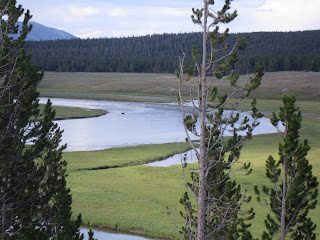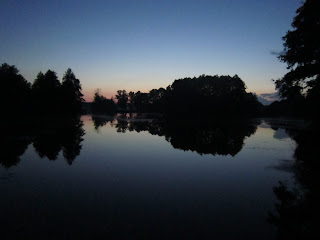Here are some photos with captions for your perusal.
This was the view from my tent ... some of the researchers had a tent with a balcony to reduce elephant disturbance that were overlooking the nearby floodplain.
Lots and lots of broad open landscapes to photo. The water in this picture was slowly infiltrating the floodplain from the mountains in Angola. It was sketchy driving on the grass because the water was invisible in parts and the soil became incredibly boggy. Had a couple of near misses, and the researchers were amazed at how much water had come through. Possibly the highest flood in 60 years, but i'm happy to be corrected.
The dust and smoke in the atmosphere helped the lighting - but the buffalo gave the afternoon its wildness.
Femke Broekhuis tracking Priya the cheetah. She is nearing the end of her PhD study looking at interactions between lions, hyenas and cheetah and inevitably had some interesting stories ... like this one time where they were calling up lions to estimate abundance and two males, aptly named Ghost and Darkness as a result, appeared out of nowhere. Or another time when she was measuring a sedated hyena, that are largely nocturnal creatures, and inquisitive lions came to see what the cars were doing. They quickly put the hyena into the back of the vehicle.
Priya and her cub Arragon.
I didn't think the log looked that big and neither did Fem, but when the right wheel leered over the top and dropped off on the next side we knew there'd be damage. Then when we dropped down the embankment to get back on the road we thought it may have been made worse. A vertical steering wheel alignment, a left wheel pointing left and a right wheel pointing right meant we had to 'make a plan' - Botswana way of saying fix the problem. So we pulled off the rod and bent it back into shape by using the tow bar and bull bar for leverage.

This deck was constructed for a visit from the royal Prince William and Prince Harry. Mat, Anna and Laura, the volunteering research assistants from America wanted to celebrate Thanksgiving so we had a bry (BBQ) over a fire in a metal pan that was sitting on 1.5 inch thick concrete slabs. Laura woke up cause she felt hot and noticed the fire, but she had been told to not leave her tent at night because there may be lions in the area. But she faced her fears and woke the crew, and we saved the camp from destruction!
Lycaon pictus African wild dog. The reason for my trip to Botswana. I watched two packs with pups on various occasions. On one of those occasions, the dominant female Sarah moved all 9 of her progeny to another den over an hour and a half. Quite a rare event and we were lucky to be there at that time.
The happy couple, Kris and Neil Jordan took us to see a couple of male lions court a lioness and to record some lion roars.
They don't think the lions killed this bull elephant because it was soo big - they think maybe disease, age or hunters had lost their trophy. It's tusks were easily as thick as my thighs and probably even bigger!
Diks (above) and Olefile (below) help keep the camp vibing! Finding lions, leopards, dogs, hyenas and working with nearby livestock producers for sustainable farm management.
Fem had to retrieve the GPS collars from her animals and new researchers were deploying solar powered collars that can accurately determine the angle that the cheetah turn when in a high speed chase. I was in the right place at the right time.
Whilst Priya was sedated, Arragon her cub kept calling for mum. Franky, sedated here, arrived with his mate Frederick to catch up with Priya, but we didn't know that when the cub started running and these two males were suddenly sprinting after him. Pretty terrifying couple of minutes!
About to crack a Bin 28 Kalimna Shiraz to have with our brie and biscuits for dinner, so we can wake up early and locate the lion Barosse, who was a couple of hours away from dog camp.
The Land Rover Canvas Hilton! Apparently my snoring kept Fem awake in her tent cause she thought I'd attract the lion that was calling in the distance before we went to bed.
Barosse
Peter Apps showing me the intricacy of identifying the compounds that may be used to alter the movements of African Wild Dogs and reduce conflict between AWD and livestock producers. The equipment is not accurate enough to identify every compound that a dog can detect with their superior olfactory ability, and our understanding of the behaviours exhibited by dogs when exposed to such compounds is generally unknown, especially in the wild. Neither Pete nor Tico have met someone with similar zoological and chemical experience to Pete so lets wish them the best of luck!
Peter Apps, myself and founder of the African wild dog Botswana Predator Conservation Trust camp, John 'Tico' McNutt. He's been in the Okavango for 20 years and hasn't yet seen a rhino, so those two rhino's in the video are the first two to colonise since their reintroduction to another part of Botswana, and like the time the dogs changed the den site, i was incredibly lucky to see them.



































































